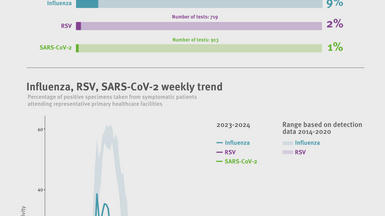Influenza virus characterisation. Summary Europe, April 2016
From week 40/2015, the start of weekly reporting on influenza activity in the WHO European Region, to week 17/2016 over 160 000 influenza detections across the Region have been reported. Influenza type A viruses have prevailed over type B but, unlike the situation in the 2014–15 season, A(H1N1)pdm09 viruses greatly outnumbered A(H3N2), and the proportion of B/Victoria-lineage detections has risen substantially, representing ~92% of those assigned to a lineage.To date, 25 EU/EEA countries have shared 600 influenza-positive specimens with the Francis Crick Institute, London, for detailed characterisation: one additional country and 128 specimens since the March 2016 report. Since the latter report, 70 viruses have been characterised antigenically and genetic analyses are ongoing.
Of 45 A(H1N1)pdm09 viruses characterised antigenically, 44 were similar to the vaccine virus A/California/7/2009. Worldwide new genetic subclusters of viruses within the 6B clade have emerged, with two being designated as subclades: 6B.1 defined by HA1 amino acid substitutions S162N and I216T and 6B.2 defined by HA1 amino acid substitutions V152T and V173I. Of the 214 viruses characterised genetically for the 2015–2016 season, 25 (12%) were clade 6B, 182 (85%) were subclade 6B.1, and seven (3%) were subclade 6B.2.
The four A(H3N2) test viruses characterised by haemagglutination inhibition (HI) assay were poorly recognised by reference antiserum raised against egg-propagated A/Switzerland/9715293/2013, the vaccine virus recommended for use in the 2015–2016 northern hemisphere influenza season. The test viruses were recognised somewhat better by antisera raised against egg-propagated A/Hong Kong/4801/2014, the virus recommended for use in 2016 southern hemisphere and 2016–2017 northern hemisphere influenza vaccines. Of 65 A(H3N2) viruses characterised genetically for the 2015–2016 season: one (1%) was clade 3C.3, 40 (62%) were subclade 3C.2a and 24 (37%) were subclade 3C.3a.
The 15 B/Victoria-lineage viruses were antigenically similar to tissue culture-propagated surrogates of B/Brisbane/60/2008. All 63 viruses characterised genetically for the 2015–2016 season fell in genetic clade 1A, as do recently collected viruses worldwide. Six B/Yamagata viruses have been characterised since the previous report; all reacted well with post-infection ferret antiserum raised against egg-propagated B/Phuket/3073/2013, the recommended vaccine virus for the northern hemisphere 2015–16 influenza season and for quadrivalent vaccines in the 2016 southern hemisphere and 2016–17 northern hemisphere seasons. All 10 viruses characterised genetically for the 2015–2016 season fell in genetic clade 3.







